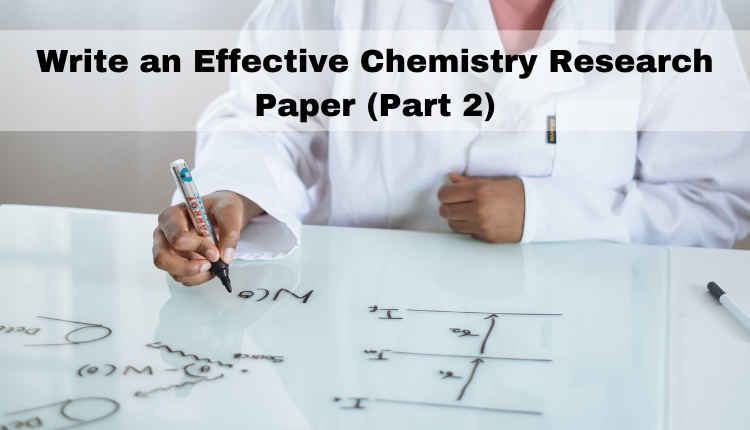(If you haven’t read the first part of this series, you can read it here).
Here, we will explain the scientific conventions and writing styles adhered to in chemistry papers. You can make your academic writing in chemistry effective by following and incorporating these suggestions. Another way of getting such assistance is with Trinka, an online grammar checker and language correction tool which has been uniquely created for scholarly writing! It suggests corrections based on its understanding of the subtle requirements of academic writing along with subject-specific language enhancements.
Let us see look at the conventions we must remember while writing a Chemistry research paper.
Starting a Sentence
Refrain from beginning a sentence with a symbol or numerical value.
Example
× 0.5 g of NaOH was added to 5 ml of DW, and the solution was heated.
✔︎ After the addition of 0.5 g of NaOH to 5 ml of DW, the solution was heated.
Pedagogical Phrases
Avoid phrases that address the process of learning and not the science of the experiment.
Example
This experiment helped us learn about…
or
The objective of this experiment was to learn about…
Though such sentences are preferred in original articles, scientific reports/communication should concentrate solely on the data and outcomes.
Illogical Constructions
Check that a modifier phrase or the pronoun “it” refers to the intended subject.
Tip 1
To avoid dangling modifiers and unclear antecedents, think about the subject.
Example
× Being coated with grease, I cleaned the flask before adding reagents.
Was I coated with grease or the flask?
The flask was coated with grease, and so,
✔︎ Because the flask was coated with grease, it was cleaned before adding reagents.
Personal Pronouns
As scientific experiments display facts that do not depend on the observer, reports should avoid using the first and second person pronouns (I/my/me/we/our/us/you/your).
Example
× I filtered the solution and noticed the production of a yellow powder.
✔︎ Filtration of the solution yielded a yellow powder.
When referring to your own outcomes or conclusions, it is apt to use the first/second person.
Example
While AB et al. report X value, the authors’ data indicate Y value.
or
AB et al. report X value, but our data yield Y value.
Active Voice
Whenever possible, use active voice.
Example
× Passive: Historically, nursing has been adversely manipulated by the tobacco lobby, putting patient care at risk.
✔︎ Active: Historically, the tobacco lobby has adversely manipulated nursing, putting patient care at risk.
Personification
Do not personify compounds and equipment.
Example
× The spectrum shows two bands of equal intensity.
✔︎ Two bands of equal intensity appear in the spectrum.
Plural Nouns
Verb usage when stating the amount of chemical reagent and terms such as data (singular: datum) and spectra (spectrum) is frequently confused.
A quantity used is a singular subject, even when that quantity is in a plural form of units.
Example
× While the solution boiled, 5.0 g of KBr were added.
✔︎ While the solution boiled, 5.0 g of KBr was added.
Verb Tense and “Verbing” a Noun
Generally, journal guidelines state the tense to be followed in every section of the manuscript.
Tip 2
Use past tense to explain a procedure:
Hydrochloric acid was added to the flask slowly to prevent the decomposition of the product.
Use present tense to explain a scientific fact:
Hydrochloric acid is a caustic substance that must be used with caution.
“Verbing” a noun, i.e., turning a noun into a verb makes the sentence ambiguous and must be avoided.
Example
× X complexes to Y
✔︎ X forms complexes with Y
Abbreviations, Formulae, and Numerals
Describe abbreviations for chemical compounds or ligands in the first instance. However, standard organic abbreviations (e.g., Me = methyl, Pr = isopropyl) can be used without definition. Use chemical formulae for standard compounds but not when the name is shorter or more precise.
Example
- NaOH (aq) for sodium hydroxide
- Caffeine for C8H10N4O2
Long compound names can be numbered if repeated often. The number should be bold or underlined, described when first presented, and should appear in parentheses when used as an adjective.
Example
Investigations into 8-hydroxyquinoline (1) and 4-iodo-8-hydroxyquinoline (2) are described. Recrystallization of 1 and 2…
Use a leading zero for values less than unity and avoid values with numerous zeroes (use scientific notation instead) for decimals.
Example
× .15 mm, ✔︎ 0.15 mm
× 0.000024 mM, ✔︎ 2.3 × 10–4 mM
Chemical Names
Chemical names are not capitalized except when they are tradenames (e.g., Tylenol).
Example
× The reaction of Cobalt (II) was…
✔︎ The reaction of cobalt (II) was…
Terms and Expressions
Use terms such as “synthesizing” new compounds and “preparing” solutions; avoid terms such as “products were created.” With/Using/By/On—refrain from using these interchangeably as they might be inaccurate in a few cases.
Example
Spectra are measured “with/using” and not “on” a spectrometer.
Tip 3
Spectrometers, colorimeters, etc. should be referred to as “instruments,” not “machines.”
The intransitive verb “react” is the most used term in chemistry papers. It should not have an object or be in the passive voice. Chemical reagents react with each other; they are not reacted.
Example
× A and B were reacted to produce C and D.
✔︎ The reaction of A and B, potassium hydroxide, and hydrochloric acid produced C and D.
A hypothesis can be “tested” but, for most laboratory work, the terms “measured,” “investigated,” “determined,” “calculated,” and “obtained” are more suitable.
Example
× The absorbance of the solution was tested using…
✔︎ The absorbance of the solution was measured using…
Reference: www.chemistry.kenyon.edu/getzler/08F-CourseFiles/BriefGuideWritingChemistry
While so many conventions could be too much to remember, using Trinka makes it easier to write! Trinka not only suggests words which are technically correct for your subject-area but also checks adherence to formal tone, correct word choice, appropriate usage of voice, pronouns, etc. It takes care of all the academic writing conventions, so that you can focus more on your ideas!

